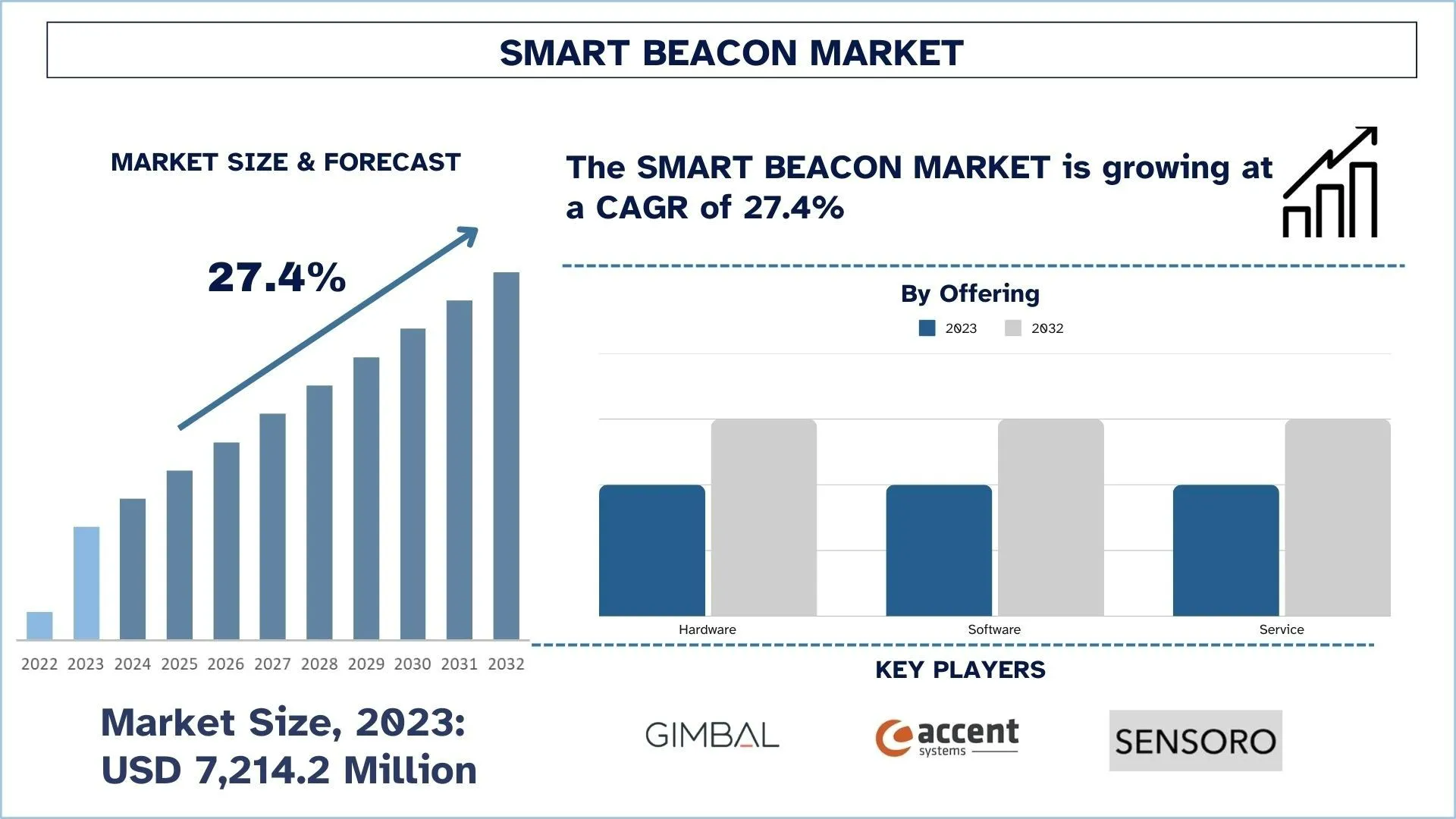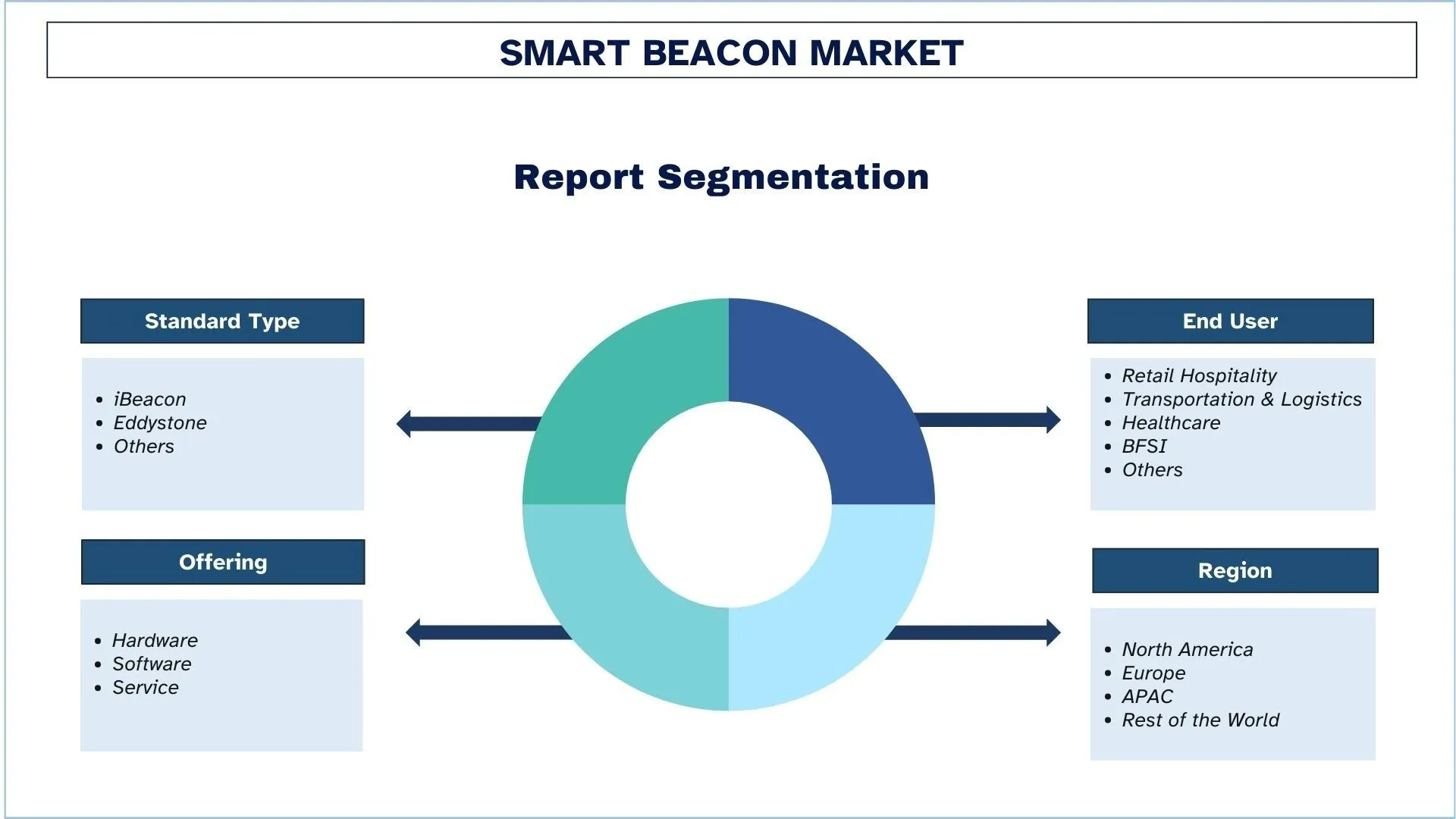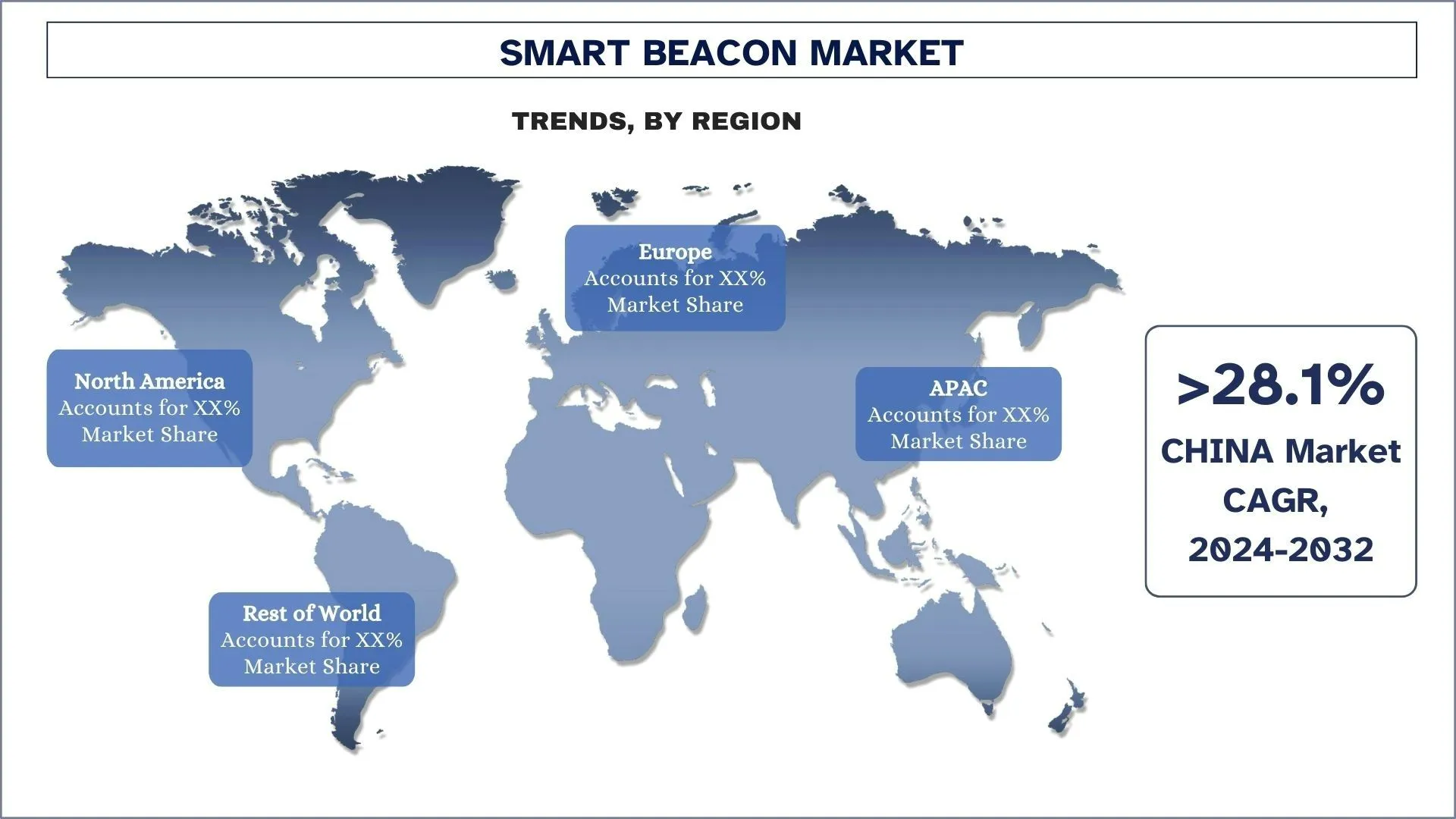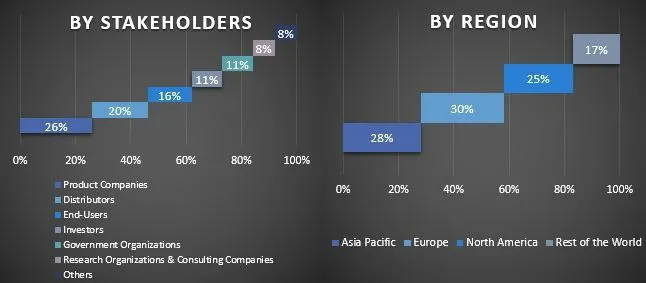- Home
- About Us
- Industry
- Services
- Reading
- Contact Us
Smart Beacon Market: Current Analysis and Forecast (2024-2032)
Emphasis on Standard Type (iBeacon, Eddystone, and Others); End User (Retail Hospitality, Transportation & Logistics, Healthcare, BFSI, and Others); Offering (Hardware, Software, and Service); Region/Country.

Smart Beacon Market Size & Forecast
The Smart Beacon Market was valued at USD 7,214.2 Million in 2023 and is expected to grow at a robust CAGR of around 27.4% during the forecast period (2024-2032) owing to the rising demand for personalized marketing, the rise of IoT adoption, and the growing need for location-based services across various industries.
Smart Beacon Market Analysis
The Smart Beacon Market includes Bluetooth Low Energy devices offering proximity-based communication to smartphones and related equipment. Businesses use these signals to send location-dependent services including targeted ads plus location monitoring. The market keeps showing strong growth because IoT technology improves and more businesses start using location-based promotional strategies. The market grows rapidly because businesses want to serve customers with tailored experiences while directing their digital messages in real time across smartphones.
Asia-Pacific (APAC) region will lead the smart beacon market growth since many people in China and India use digital devices and have smartphones. China's smart city projects and India's retail growth push people to use smart beacon equipment. Southeast Asian nations are using beacons to enhance transportation, logistics, and tourism functions which creates many new possibilities for market participants. The market will keep growing because of both the area's growing infrastructure projects plus supportive government rules for its middle-class citizens.
Smart Beacon Market Trends
This section discusses the key market trends that are influencing the various segments of the Smart Beacon as identified by our team of research experts.
Government Policies Supporting the Smart Beacon Industry
The Smart Beacon industry benefits from government actions that help its development and creative progress. The plans set regulatory standards to increase smart technology use while protecting personal data and network security. Below are data-driven insights on how government actions are advancing this sector:
Smart City Initiatives: Governments develop smart city projects using modern tech features including smart beacon systems to improve urban management platforms and public transportation while boosting service quality.
Digital Transformation Incentives and Grants: Governments reward digital technology investments when companies use beacon systems to improve their business operation and customer engagement.
Public-Private Partnerships (PPP) for Technology Deployment: Public and private sector organizations team up to add smart beacon technology across public facilities and shopping areas along with transportation hubs to make this technology more effective in city environments.
Data Protection and Privacy Regulations (e.g., GDPR): GDPR regulation defends consumer privacy by making businesses that use beacon technology follow strong security rules which builds trust in the system.
Funding for Research and Development in IoT and Smart Technologies: By funding research into the Internet of Things technology governments speed up smart beacon development in different market sectors.
Tax Incentives for Businesses Adopting Smart Technologies: Governments support businesses with tax benefits and perks when they add smart beacon technologies to cut operating expenses and encourage full IoT system adoption.
Standards and Regulations for Bluetooth and IoT Connectivity: Governments develop common technical guidelines for Bluetooth and IoT devices to help smart beacon systems operate reliably and work with each other which advances market growth when products interconnect.
Support for Infrastructure Development in Urban and Rural Areas: Government officials focus on modernizing infrastructure by adding better internet access and creating rules that let organizations deploy IoT technology including beacons across all areas.
Subsidies for Technology Startups in Beacon and IoT Space: Governments help startups in Beacon and IoT through funding and discounts to develop fresh ideas plus let new companies compete against existing businesses.
Promotion of Location-Based Services and Digital Marketing Policies: Governments now support businesses that use beacon technology as a digital marketing tool to better engage customers while boosting their shopping experience.

APAC is Expected to Grow with Significant CAGR During Forecast Period
The Smart Beacon Market in APAC grows rapidly as the area's quick population growth meets increased smartphone usage and rising IoT acceptance rates. Several APAC nations stand out including China, India, and Japan which place smart beacons throughout retail stores, hospitals, transportation networks, and tourism locations. Digital services growth across e-commerce and government-backed transformation efforts drive APAC businesses to adopt location-based tech for improved customer contact. Beacon technology performs effectively at low costs, and it shows promise to APAC businesses that want to serve customers better while running operations more smoothly.
Smart city and smart infrastructure projects across APAC create many opportunities for smart beacon framework applications. Urban development projects in China use beacon technology to help improve both public services and transportation networks. More retail businesses and hotels in India turn digital which creates a higher need for local marketing technologies. The Smart Beacon Market in APAC will experience strong growth given the region's lead in population count smartphone adoption and digital platform construction.

Smart Beacon Industry Overview
The Smart Beacon market is competitive and fragmented, with the presence of several global and international market players. The key players are adopting different growth strategies to enhance their market presence, such as partnerships, agreements, collaborations, new product launches, geographical expansions, and mergers and acquisitions. Some of the major players operating in the market are Aruba Networks (Hewlett Packard Enterprise Development LP), HID Global Corporation, Mokosmart, Cisco Systems Inc., Kontakt.io Inc., Gimbal Inc., Accent Systems, Sensoro Co. Ltd, Radius Networks, Inc., and Fujitsu Components Asia Pte Ltd.
Smart Beacon Market Report Coverage
Report Attribute | Details |
Base year | 2023 |
Forecast period | 2024-2032 |
Growth momentum | Accelerate at a CAGR of 27.4% |
Market size 2023 | USD 7,214.2 Million |
Regional analysis | North America, Europe, APAC, Rest of the World |
Major contributing region | Asia-Pacific is expected to grow at the highest CAGR during the forecasted period |
Key countries covered | U.S., Canada, Germany, Spain, Italy, France, United Kingdom, China, Japan, Australia, and India |
Companies profiled | Aruba Networks (Hewlett Packard Enterprise Development LP), HID Global Corporation, Mokosmart, Cisco Systems Inc., Kontakt.io Inc., Gimbal Inc., Accent Systems, Sensoro Co. Ltd, Radius Networks, Inc., and Fujitsu Components Asia Pte Ltd. |
Report Scope | Market Trends, Drivers, and Restraints; Revenue Estimation and Forecast; Segmentation Analysis; Demand and Supply Side Analysis; Competitive Landscape; Company Profiling |
Reasons to buy this report:
The study includes market sizing and forecasting analysis validated by authenticated key industry experts.
The report presents a quick review of overall industry performance at one glance.
The report covers an in-depth analysis of prominent industry peers with a primary focus on key business financials, product portfolios, expansion strategies, and recent developments.
Detailed examination of drivers, restraints, key trends, and opportunities prevailing in the industry.
The study comprehensively covers the market across different segments.
Deep dive regional level analysis of the industry.
Customization Options:
The global Smart Beacon Market can further be customized as per the requirement or any other market segment. Besides this, UMI understands that you may have your own business needs, hence feel free to contact us to get a report that completely suits your requirements.
Table of Content
Research Methodology for the Smart Beacon Market Analysis (2024-2032)
Analyzing the historical market, estimating the current market, and forecasting the future market of global Smart Beacon Market were the three major steps undertaken to create and explore the adoption of Smart Beacon Market in major regions globally. Exhaustive secondary research was conducted to collect the historical market numbers and estimate the current market size. Secondly, numerous findings and assumptions were taken into consideration to validate these insights. Moreover, exhaustive primary interviews were also conducted with industry experts across the value chain of the global Smart Beacon Market. Post assumption and validation of market numbers through primary interviews, we employed a top-down/bottom-up approach to forecasting the complete market size. Thereafter, market breakdown and data triangulation methods were adopted to estimate and analyze the market size of segments and sub-segments of the industry. Detailed methodology is explained below:
Analysis of Historical Market Size
Step 1: In-Depth Study of Secondary Sources:
A detailed secondary study was conducted to obtain the historical market size of the Smart Beacon through company internal sources such as annual reports & financial statements, performance presentations, press releases, etc., and external sources including journals, news & articles, government publications, competitor publications, sector reports, third-party database, and other credible publications.
Step 2: Market Segmentation:
After obtaining the historical market size of Smart Beacon, we conducted a detailed secondary analysis to gather historical market insights and share for different segments and sub-segments for major regions. Major segments are included in the report such as Standard Type, End User, and Offering. Further country-level analyses were conducted to evaluate the overall adoption of testing models in that region.
Step 3: Factor Analysis:
After acquiring the historical market size of different segments and sub-segments, we conducted a detailed factor analysis to estimate the current market size of the Smart Beacon. Further, we conducted factor analysis using dependent and independent variables such as Standard Type, End User, and Offering of the Smart Beacon Market. A thorough analysis was conducted of demand and supply-side scenarios considering top partnerships, mergers and acquisitions, business expansion, and product launches in the Smart Beacon sector across the globe.
Current Market Size Estimate & Forecast
Current Market Sizing: Based on actionable insights from the above 3 steps, we arrived at the current market size, key players in the global Smart Beacon, and market shares of the segments. All the required percentage shares split, and market breakdowns were determined using the above-mentioned secondary approach and were verified through primary interviews.
Estimation & Forecasting: For market estimation and forecast, weights were assigned to different factors including drivers & trends, restraints, and opportunities available for the stakeholders. After analyzing these factors, relevant forecasting techniques i.e., the top-down/bottom-up approach were applied to arrive at the market forecast for 2032 for different segments and sub-segments across the major markets globally. The research methodology adopted to estimate the market size encompasses:
The industry’s market size, in terms of revenue (USD) and the adoption rate of the Smart Beacon across the major markets domestically
All percentage shares, splits, and breakdowns of market segments and sub-segments
Key players in the global Smart Beacon Market in terms of products offered. Also, the growth strategies adopted by these players to compete in the fast-growing market
Market Size and Share Validation
Primary Research: In-depth interviews were conducted with the Key Opinion Leaders (KOLs) including Top Level Executives (CXO/VPs, Sales Head, Marketing Head, Operational Head, Regional Head, Country Head, etc.) across major regions. Primary research findings were then summarized, and statistical analysis was performed to prove the stated hypothesis. Inputs from primary research were consolidated with secondary findings, hence turning information into actionable insights.
Split of Primary Participants in Different Regions

Market Engineering
The data triangulation technique was employed to complete the overall market estimation and to arrive at precise statistical numbers for each segment and sub-segment of the global Smart Beacon Market. Data was split into several segments & sub-segments post studying various parameters and trends in the areas of Standard Type, End User, and Offering in the global Smart Beacon Market.
The main objective of the Global Smart Beacon Market Study
The current & future market trends of the global Smart Beacon were pinpointed in the study. Investors can gain strategic insights to base their discretion for investments on the qualitative and quantitative analysis performed in the study. Current and future market trends determined the overall attractiveness of the market at a regional level, providing a platform for the industrial participant to exploit the untapped market to benefit from a first-mover advantage. Other quantitative goals of the studies include:
Analyze the current and forecast market size of the Smart Beacon in terms of value (USD). Also, analyze the current and forecast market size of different segments and sub-segments
Segments in the study include areas of Standard Type, End User, and Offering
Define and analysis of the regulatory framework for the Smart Beacon industry
Analyze the value chain involved with the presence of various intermediaries, along with analyzing customer and competitor behaviors of the industry
Analyze the current and forecast market size of the Smart Beacon for the major region
Major countries of regions studied in the report include Asia Pacific, Europe, North America, and the Rest of the World
Company profiles of the Smart Beacon and the growth strategies adopted by the market players to sustain in the fast-growing market
Deep dive regional level analysis of the industry.
Frequently Asked Questions FAQs
Q1: What is the current market size and growth potential of the Smart Beacon market?
The Smart Beacon Market was valued at USD 7,214.2 Million in 2023 and is expected to grow at a CAGR of 27.4% during the forecast period (2024-2032).
Q2: What are the driving factors for the growth of the Smart Beacon market?
The growth of the Smart Beacon market is driven by the increasing demand for location-based services and personalized marketing solutions.
Q3: Which segment has the largest share in the Smart Beacon market by End User?
The Retail Hospitality segment has the largest share of the Smart Beacon Market by End User.
Q4: What are the emerging technologies and trends in the Smart Beacon market?
Ans: Emerging technologies and trends in the Smart Beacon market include the integration of IoT devices, advancements in Bluetooth Low Energy (BLE), and the rise of AI-driven personalized marketing solutions.
Q5: Which region will dominate in the Smart Beacon market?
APAC is expected to dominate the market during the forecast period.
Related Reports
Customers who bought this item also bought










